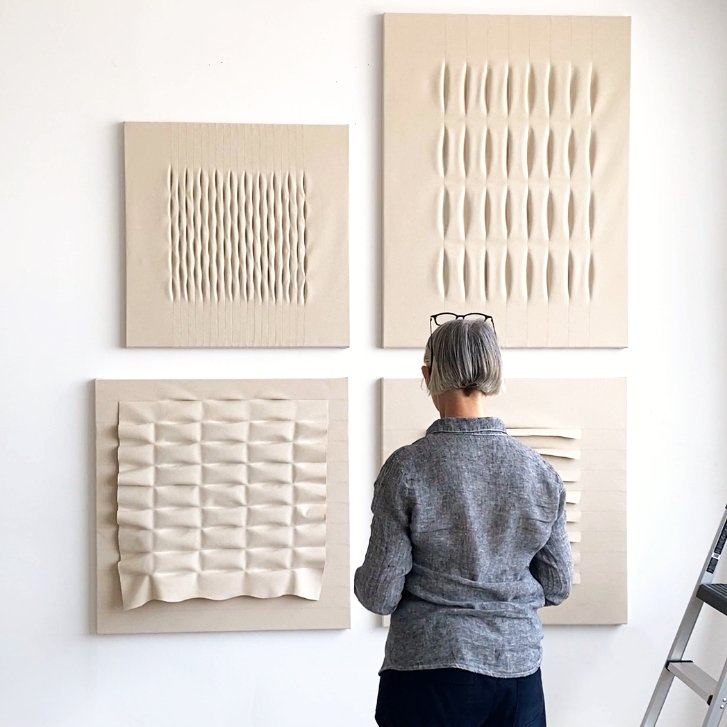I have Jason Stein, Bonhams Director of Modern Decorative Art + Design, to thank for his suggestion that I make some work in editions. That was back in 2015 when he came to dinner at my studio. I don’t think he knows how important that advice was. He may not even remember he gave it.
I’ll acknowledge it here and now--thank you, Jason!
He said, there are always people who are going to want more accessible work. Even then, I was making work on the larger side, and he advised too that my collectors would be looking for small pieces for smaller rooms. So, I set about creating work I could repeat, and make to order, up to 25 times. These are known as “editions of 25”. I decided they would be stretched taut on wooden stretcher bars, to be easy to handle and hang.
Over the years many of these editions have been made and are now in collections around the world. Maybe you have one yourself. Or, maybe right now, you’re thinking to stop reading this blog, to go check out the editions and choose one for yourself…but wait!
I have news of a new set of four editioned pieces named Toile, pronounced “twäl,” a version of a garment made by a designer to test a pattern. The etymology of this word is grounded in the world of fashion, usually referring to apparel. In Toile, I use canvas, similar to but heavier than the muslin used in the construction of these types of garments. Each new work is structured to express linear repetitions and has been refined through multiple iterations, just as a traditional garment toile.
My edition works are a means for me to explore how my palette of forms and use of repetition can be transformed and developed when the surfaces are stretched taut; rather than being allowed to hang and be shaped by their own surface tensions and the pull of gravity.
In this new set of editions, I’ve incorporated a combination of both the free-hanging layers and stretched forms in the works. I’ve extended the subtleties of proportion, form, and surface. They’re framed arrangements of soft imbalance and fluidity.
The first in the editions, Hume, looks back to Bradley, from my Double series, with its double layers sewn into each other. There is a smoothness and steadiness to the work, more so than in Bradley, due to the structured frame. From the front, it looks almost like the lines in a notebook, the second layer creating shadows beneath each row to add depth and dimension. The rows jutting out are even but crease as they wish, and the softness is made stronger by the volume and repetition of layers, drawing your eye to the center.
Hume - detail - unbleached cotton canvas on wood stretcher frame 36”h x 36”w 3”d 91cm x 91cm x 8cm
Fitt comes from Gransha and Ballycastle, both of my Moss series, taking the pattern found in both and reworking it in a way that enhances the feeling of being balanced and refined. While this pattern typically creates a rippled effect on the canvas, when it’s pulled taut on the frame, it becomes a contained, quiet arrangement. Fitt feels more delicate than the other Toile editions.
Fitt - detail - unbleached cotton canvas on wood stretcher frame 32”h x 32”w 2”d 81cm x 81cm x 5cm
The third in the editions is Trimble, coming originally from Munn of my previous Ennis series, as well as Warnock from my Double series. When I first began using this pattern, I took a wabi-sabi approach, allowing the pleats to crinkle wherever they wanted. I’ve done the same here in Trimble. This second layer lifts from the taut canvas beneath, it feels large and orderly, with its wide horizontal pleats arranged into three even pillowed columns.
Trimble - detail - unbleached cotton canvas on wood stretcher frame 36”h x 36”w 3”d 91cm x 91cm x 8cm
Sands was not named after a landscape, but still evokes thoughts of tiny marks in the sand along the shore, showing the path of a bird or crab. Its lineage is from Flanagan of the Ennis series, except here I’ve turned the pattern vertically and sewn it into the tautly pulled canvas layer. While the pattern is even, the overall arrangement of Sands is asymmetrical, with the left margin holding greater space than the right. It’s almost a book spine for the story that writes itself over the work in precisely spaced columns and rows.
Sands - detail - unbleached cotton canvas on wood stretcher frame 48”h x 36”w 2”d 122cm x 91cm x 5cm
Enough of words! Now is a good time to see what each canvas looks like. Here in Numbered Editions are multiple views of each work, along with dimensions and current prices, so you can see if there is a Toile piece that could be a good fit.
Email me if you would like to know more.




